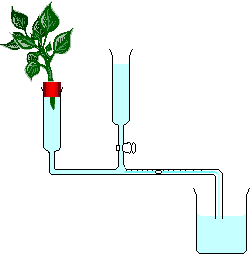
Potometer works on the principle of
(A) Osmotic pressure
(B) Amount of water absorbed equals the amount transpired
(C) Root pressure
(D) Potential difference between tip of tube and that of plant
Answer
574.8k+ views
Hint: Potometer is an instrument used to measure the amount of water lost through the stomatal openings in the leaves by the process of transpiration. Hence a potometer is also known as a transpirometer. It gives the output of rate of transpiration of the water.
Complete Answer:
- Transpiration is defined as the amount of water that is lost through the small minute pores in the leaves of the plants. These openings are called stomata. This process of transpiration by the stomata is controlled by the action of guard cells.
- The potassium ions that present in the guard cells move in and out of it and maintain the turgor pressure in these cells. When there is lots of potassium ions in the guard cells, water from the neighbor cells moves into the guard cells this causes bulging of them. Hence the stomata open.
- Closing mechanism is the opposite phenomenon to the opening of the guard cell. The water moves out and it compresses by causing the stomata pores to close.

- This photometer functions by finding whether the water intake in the root zone is equal to the water lost through the transpiration.
- Hence it works on the principle that the amount of water absorbed equals the amount transpired.
Thus, the option (C) is correct.
Note: The output value from the potometer that is the rate of transpiration mainly depends on the intensity of the sunlight that falls on the leaves, temperature of the surrounding air, humidity and the speed and the intensity of the wind.
Complete Answer:
- Transpiration is defined as the amount of water that is lost through the small minute pores in the leaves of the plants. These openings are called stomata. This process of transpiration by the stomata is controlled by the action of guard cells.
- The potassium ions that present in the guard cells move in and out of it and maintain the turgor pressure in these cells. When there is lots of potassium ions in the guard cells, water from the neighbor cells moves into the guard cells this causes bulging of them. Hence the stomata open.
- Closing mechanism is the opposite phenomenon to the opening of the guard cell. The water moves out and it compresses by causing the stomata pores to close.

- This photometer functions by finding whether the water intake in the root zone is equal to the water lost through the transpiration.
- Hence it works on the principle that the amount of water absorbed equals the amount transpired.
Thus, the option (C) is correct.
Note: The output value from the potometer that is the rate of transpiration mainly depends on the intensity of the sunlight that falls on the leaves, temperature of the surrounding air, humidity and the speed and the intensity of the wind.
Recently Updated Pages
Master Class 10 General Knowledge: Engaging Questions & Answers for Success

Master Class 10 Science: Engaging Questions & Answers for Success

Master Class 10 Social Science: Engaging Questions & Answers for Success

Master Class 10 Maths: Engaging Questions & Answers for Success

Master Class 10 English: Engaging Questions & Answers for Success

Master Class 10 Computer Science: Engaging Questions & Answers for Success

Trending doubts
The shortest day of the year in India

Why is there a time difference of about 5 hours between class 10 social science CBSE

Write a letter to the principal requesting him to grant class 10 english CBSE

What is the median of the first 10 natural numbers class 10 maths CBSE

The Equation xxx + 2 is Satisfied when x is Equal to Class 10 Maths

State and prove converse of BPT Basic Proportionality class 10 maths CBSE




